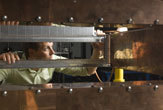This
Behind the Scenes article was provided to LiveScience in partnership with the National Science Foundation.
The strong nuclear force is the strongest of the four fundamental forces of nature, binding protons and neutrons in the cores of atoms. Yet the same force prevents those fundamental particles from combining in certain combinations.
When I first learned that, my entire view of the physical world was shaken. It was like learning that only certain mixes of peanut butter and jelly could be put into a sandwich.
As a journalist at the National Superconducting Cyclotron Laboratory (NSCL) at Michigan State University, one of the nation's top nuclear science laboratories, the strangeness of this truth was my first glimpse into the peculiar nature of matter at the subatomic level.

|
| ©NSCL
|
| Matt Johnson, NSCL staff engineer, inspects a 45-degree dipole magnet. The magnet, used to turn and separate nuclei, was installed in 2007, enabling researchers to continue pursuing exotic nuclei at the edge of existence.
|
Full of uncertaintiesScientists' knowledge of the strong nuclear force is full of uncertainties. To learn more, physicists are going to the extremes of nuclear existence in pursuit of understanding the neutron dripline. The term refers to a boundary on a graph plotting the number of neutrons in a nucleus against the number of protons, but it reflects how many neutrons can be piled into a single nucleus before the particles begin to bounce off. This has preoccupied nuclear physicists for the past half century, and for many it is about more than understanding the nuclear force.
"We want to explore things as far away from what we know as possible," said Alex Brown, a professor of physics at NSCL. "This is testing new aspects of our models that we are not able to see in any other way. What are the constituents of our world? How many nuclei exist? And how are they formed in the process of the evolution of the universe? All of that depends on where the dripline is."
Brown and his colleagues recently discovered three nuclei near the dripline that had never been observed before. Magnesium 40 with 12 protons and 28 neutrons was the goal of the experiment, and it was a hot find - pursued for more than twenty years without success. But most surprising were the two other nuclei - aluminum 42 and aluminum 43 - that physicists thought should not have existed at all.
"The implication is that our models still have a long way to go," said Brad Sherrill, university distinguished professor of physics at Michigan State University. "Surprises eventually lead to a deeper understanding of the science," Sherrill said. "But at the moment, it's just a surprise."
One-hundred eighteen elements have been observed in the universe, but the neutron dripline has been found for only the first eight.
"You would think, if it's so interesting to explore the dripline, why hasn't it been done yet?" asks Thomas Baumann, a beam physicist at NSCL and lead researcher on the magnesium and aluminum study.
So Baumann and his colleagues started a search at NSCL.
Half of light-speedIn an experiment that ran earlier this year, the cyclotron accelerated a beam of calcium nuclei to nearly half the speed of light - fast enough to circle the Earth three times in one second. The nuclei collide into a tungsten target, producing a thick smattering of various nuclei and other particles. Only one out of billions - sometimes trillions or quadrillions - of the resultant nuclei is the one that researchers seek. Producing the desired nucleus by knocking out an exact number of protons and while leaving the neutrons untouched is akin to throwing a chocolate chip cookie at the wall and knocking out only chocolate chips.
A complex system of magnets downstream filters out the desired particles, and over 11 days, three particles of magnesium 40 were detected, a proportion comparable to finding three particles of sand in all the beaches of western North America.
"Everything has to work perfectly," said Kirby Kemper, a collaborator from Florida State University. "It's the golden amount, when everything you've worked for comes together and works - that's what you live for as a scientist."
The findings showed physicists that the neutron dripline is not as well understood as they thought, and to better define it they must venture into rarer nuclei.
For every nucleus closer to the dripline, Sherrill estimates that experimentally producing it would be 100 to 1000 times harder, requiring more powerful equipment or taking much more time.
"We made magnesium 40 in 11 days. Making magnesium 42 [with current technology] would take 1100 days. That's 3 years of running. It's kind of impossible," Sherrill said. As a more realistic alternative, physicists stress the need to continue to develop new technology. "One hundred years from now when people are a lot smarter, this will all be really easy," Sherill added. And so the pursuit proceeds.
Reader Comments
to our Newsletter